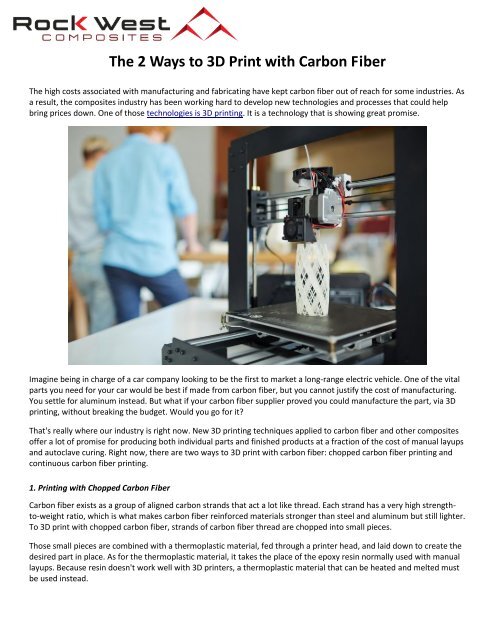The 2 Ways to 3D Print with Carbon Fiber
The high costs associated with manufacturing and fabricating have kept carbon fiber out of reach for some industries. As a result, the composites industry has been working hard to develop new technologies and processes that could help bring prices down. One of those technologies is 3D printing. It is a technology that is showing great promise. Visit: https://www.rockwestcomposites.com/blog/rapid-prototyping-and-3d-printing-a-perfect-match/
The high costs associated with manufacturing and fabricating have kept carbon fiber out of reach for some industries. As a result, the composites industry has been working hard to develop new technologies and processes that could help bring prices down. One of those technologies is 3D printing. It is a technology that is showing great promise. Visit: https://www.rockwestcomposites.com/blog/rapid-prototyping-and-3d-printing-a-perfect-match/
- No tags were found...
Create successful ePaper yourself
Turn your PDF publications into a flip-book with our unique Google optimized e-Paper software.
<strong>The</strong> 2 <strong>Ways</strong> <strong>to</strong> <strong>3D</strong> <strong>Print</strong> <strong>with</strong> <strong>Carbon</strong> <strong>Fiber</strong><br />
<strong>The</strong> high costs associated <strong>with</strong> manufacturing and fabricating have kept carbon fiber out of reach for some industries. As<br />
a result, the composites industry has been working hard <strong>to</strong> develop new technologies and processes that could help<br />
bring prices down. One of those technologies is <strong>3D</strong> printing. It is a technology that is showing great promise.<br />
Imagine being in charge of a car company looking <strong>to</strong> be the first <strong>to</strong> market a long-range electric vehicle. One of the vital<br />
parts you need for your car would be best if made from carbon fiber, but you cannot justify the cost of manufacturing.<br />
You settle for aluminum instead. But what if your carbon fiber supplier proved you could manufacture the part, via <strong>3D</strong><br />
printing, <strong>with</strong>out breaking the budget. Would you go for it?<br />
That's really where our industry is right now. New <strong>3D</strong> printing techniques applied <strong>to</strong> carbon fiber and other composites<br />
offer a lot of promise for producing both individual parts and finished products at a fraction of the cost of manual layups<br />
and au<strong>to</strong>clave curing. Right now, there are two ways <strong>to</strong> <strong>3D</strong> print <strong>with</strong> carbon fiber: chopped carbon fiber printing and<br />
continuous carbon fiber printing.<br />
1. <strong>Print</strong>ing <strong>with</strong> Chopped <strong>Carbon</strong> <strong>Fiber</strong><br />
<strong>Carbon</strong> fiber exists as a group of aligned carbon strands that act a lot like thread. Each strand has a very high strength<strong>to</strong>-weight<br />
ratio, which is what makes carbon fiber reinforced materials stronger than steel and aluminum but still lighter.<br />
To <strong>3D</strong> print <strong>with</strong> chopped carbon fiber, strands of carbon fiber thread are chopped in<strong>to</strong> small pieces.<br />
Those small pieces are combined <strong>with</strong> a thermoplastic material, fed through a printer head, and laid down <strong>to</strong> create the<br />
desired part in place. As for the thermoplastic material, it takes the place of the epoxy resin normally used <strong>with</strong> manual<br />
layups. Because resin doesn't work well <strong>with</strong> <strong>3D</strong> printers, a thermoplastic material that can be heated and melted must<br />
be used instead.
<strong>The</strong> finished product resulting from chopped carbon fiber printing is more or less a carbon fiber reinforced plastic. It is<br />
much stronger and more durable than alternative materials, but it is not as strong as it could be due <strong>to</strong> the embedded<br />
fibers being chopped in<strong>to</strong> small pieces. When we need something stronger, we turn <strong>to</strong> continuous carbon fiber printing.<br />
2. <strong>Print</strong>ing <strong>with</strong> Continuous <strong>Carbon</strong> <strong>Fiber</strong><br />
A part <strong>3D</strong> printed using this process is also a carbon fiber reinforced plastic. However, it is a stronger and more rigid<br />
material due <strong>to</strong> the differences in printing. Rather than using fibers chopped in<strong>to</strong> small pieces, this process involves a<br />
continuous thread of carbon fiber combined <strong>with</strong> the thermoplastic material.<br />
To accomplish this, two separate printheads are used. <strong>Carbon</strong> fiber thread is run through one printhead while the<br />
melted thermoplastic is forced through the other. <strong>The</strong> two combine in<strong>to</strong> a single print stream at the point of output.<br />
That single stream is then laid out, layer by layer, <strong>to</strong> print the desired part in place.<br />
An advantage of this printing method is the ability <strong>to</strong> increase or decrease strength as necessary. For example, an<br />
engineer may be working <strong>with</strong> a part that needs extra strength at one particular stress point. By modifying the printing<br />
program, the strength can be increased in that one area alone. This allows for more cus<strong>to</strong>mization of printed parts.<br />
<strong>Carbon</strong> fiber is an excellent manufacturing material that could eventually replace steel and aluminum entirely. But in<br />
order for that <strong>to</strong> happen, production costs have <strong>to</strong> come down. <strong>The</strong> advent of <strong>3D</strong> printing is moving our industry in that<br />
direction.


